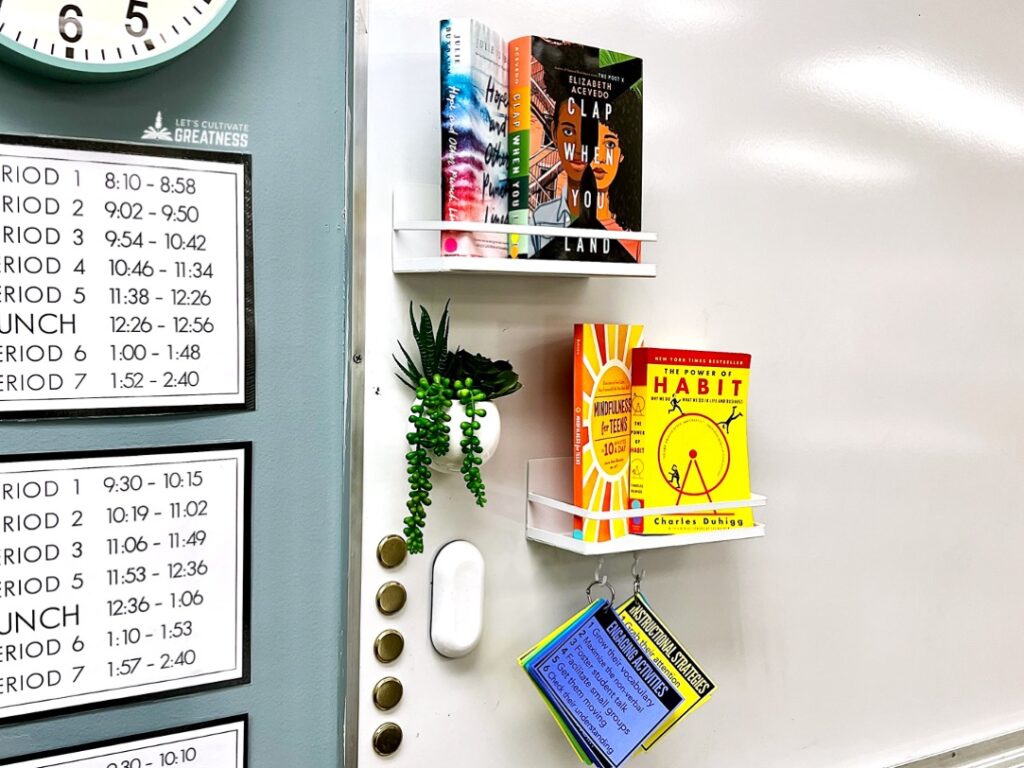This post contains affiliate links, and I may earn a small commission when you purchase them at no additional cost to you. This helps me keep this blog running.
Setting a classroom that works is tough—it’s a massive task compared to putting a few prints up in an office cubicle. Plus, it needs to function seamlessly and be durable enough to last through hundreds of kids.
Not to mention, you usually are doing it with your own money.
The most important thing to remember is that an uncluttered space is better than one filled with overstimulating walls.
So don’t feel you need to spend hundreds of dollars or have everything up by the first day of school. I have often started the year with not-yet-finished bulletin boards.
In the five classrooms I’ve had in my career, I’ve discovered the must-haves that make my social studies classes run smoothly. Things that go way beyond classroom décor.
While many of these are universal tips for any middle or high school classroom, several are social studies-specific.
Here they are, with ideas for doing them inexpensively!
Pick Content-Focused Classroom Décor
Wall Maps – Hang the largest-size wall maps you can fit, depending on what you teach.
This world map is 46x80in, perfect for a giant wall space, or this smaller one is 24x36in if that’s all your room. Same with this larger United States map that’s 48x78in or this smaller sized 24x36in one.
I also love my 3D relief United States map, which is really helpful in explaining events and helping my students study for their semester-long US geography test series.

Wall tapestry maps make an even more inexpensive option, especially with a huge blank wall space. Here’s one of a world map and one of the United States.
You will be gesturing to them and pointing things out every single day. I promise. The several seconds it takes to use a pull-down map or pull something up on Google Maps can ruin your flow.
Founding Document Posters – Post poster-sized replicas of key founding documents related to your US History and Civics classes. I love this 3-pack of the Declaration of Independence, the US Constitution, and the Bill of Rights.
Again, I point at them daily in my US History and Civics classes.

World Flags – You may also love displaying flags from around the world if you teach World History or Current World Issues. The easiest way to incorporate them is with this inexpensive pennant-style banner.
Support Skill Building
Claim Building Support – Help students take their “yes/no” answers to a higher-level qualified claim with this Argument Qualifier Continuum Line kit that fits perfectly under your whiteboard.

Whenever students say something simplistic, like “the author sounds angry” or “it caused a change,” you can point to this and ask them, “How much so?” without wasting a single second of class time. Students have the thinking; they just need a word bank!
Critical Thinking Skills – Use your wall to support additional skills you develop over the year. These Critical Thinking Skills Poster kit work for any social studies classroom.

Course-Specific Key Concepts & Skills – You may also want to highlight things specific to your courses, like these Historical Thinking Skill posters for any history class. I also have them for Civics or Sociology.
You know it’s a key concept if it comes up throughout all your units. Having some sort of classroom visual is essential to be a constant connection and reminder.

Progressive Timeline or Bulletin Board – Depending on the classes you teach, create a bulletin board that you add to throughout the course, like a timeline or hall of fame.
Similarly, you can use the space to post student projects or exemplars of skills you are hyper-focused on throughout the year.
Include Inspirational Messages
Motivational Posters – Be sure to save wall space for some breathing room and words of inspiration.
That’s why I love these minimalist 11×17 motivational messages in the space under my whiteboards using Command strips and clean front-loading frames.

I also love these 5×7 signs that fit perfectly under my wall of cabinets.

To keep it inexpensive, you can also mat them on black card stock and laminate for a similar look.
Notes of Kindness Basket – This is a bit of a non-essential but something I love in my classroom. Stuff a basket with cards for students to write notes of thanks and encouragement anytime.

I have been buying this 200-card kit for years—they’re brightly colored, sturdy, and the cheapest price-per-card I’ve found.
Share Your Personality
Social Studies Collection – Fill the corner or bookshelf behind your desk with something quirky, like actions figures of historical people, front pages of vintage newspapers, or political campaign buttons.
You can certainly build this over time, but having a “thing” will help show students your love for the subjects you teach.
Travel or Hobbies – Find a way to highlight your outside hobbies to humanize yourself. If you run 5ks, add your bibs from each race to your wall as you earn them. Or bring in a few fan items from your favorite sports team. If you want to visit all 50 states, post photos of all the states you’ve been to so far.
Organize Your Whiteboard
Weekly or Unit Calendars – Washi tape is perfect for dividing a whiteboard into sections for each class. Then add anything essential students need to know—learning targets, upcoming deadlines and assignments, and any reminders.
Having all this broader information posted keeps your daily agenda more focused and uncluttered and enables students to find answers to their questions about the class.
Whiteboard Accessories – There are so many items now that make your whiteboards much more usable.
I use these super strong magnet shelves to showcase books related to our current unit from my classroom library.
These magnetic hooks are great for hanging hall passes or things like my Instructional Strategies or Engaging Lesson flip decks.

I also love these heavy-duty magnets to post no-name assignments or unfinished tests. If it’s hanging on my whiteboard, I’m not losing it, and students see it.
Create Classroom Flow
Student Supply Station – Create a designated place for supplies students can access anytime. Include pens, pencils, tape, staplers, scissors, extra paper, a tissue box, highlighters, and a pencil sharpener.
Seriously, everything. Anything to assist your students in being self-sufficient is the goal.
Put it as far away as you can from your desk or stash of supplies to minimize confusion that the cup of pens on your desk is off-limits.
Missing Work Station – Use crates and hanging folders for pen-and-paper assignments or create a small bulletin board explaining (with visuals) where to find things on your LMS.
Again, the goal is for whatever system you create, students never have to ask you for where to find what they missed.

Bell Schedule – You should never be answering the question, “When does the bell ring?” Display all your daily bell schedules in a large-enough font size to be seen from across your room, ideally right next to your clock.
Bathroom Passes – Whatever system you choose, make it clear and implement it consistently. Even if you let students leave freely, still consider putting your sign-out clipboard and hall pass away from the door. That way, you’ll better notice when students are getting up to leave.
That’s why I specifically hang my hall pass lanyards on my front whiteboard. I’ve also found that bit of extra walking minimizes kids leaving who don’t really have to use the bathroom.
Make it Work for You
Tech Set-up – Every second matters during a lesson. Even the 5 seconds it takes to skip a YouTube ad can dimmish the flow you had going, so make sure you have all your tech working for you, not against you.
If something isn’t seamlessly connecting with your LMS, ask your tech person or colleagues for an alternative or what they do.
Submit a tech ticket if it takes longer than necessary for your projector, doc camera, or laptop to connect.
Consider getting a second monitor, which makes everything from building lecture slides and lessons to entering grades much easier.
And if you do lecture even occasionally, pick up a wireless presenter remote so you can walk around the room for better classroom management while you’re talking.
Comforts – Teaching’s hard, whether you’re in your first year or a veteran. You may not have any natural light, you have 30 minutes bell-to-bell to eat lunch, and you might have 4 hours straight until your prep, so be kind to yourself.
If pandemic teaching taught me anything, it’s that if there is anything that can make my space more pleasant, I’m doing it.
Get that electric kettle or Nespresso machine. This compact Vertuo model is always running at 10:30 each day in my room!
Get a mug warmer so your drink stays toasty.
Use lamps around your room so you don’t have to turn on all those fluorescent lights.
Keep a stash of sparkling water nearby.
Have a warm lap blanket or extra fleece jacket on hand during the winter.
Seriously, if it makes your space a better place to work, do it.
I hope these classroom décor and classroom setup tips help you create a room you can call home. Click here to see the rest of my classroom posters and bulletin board kits.





